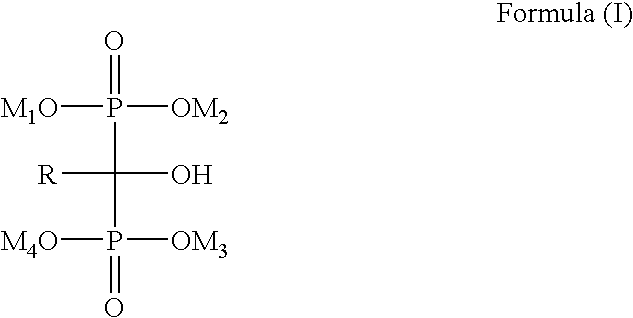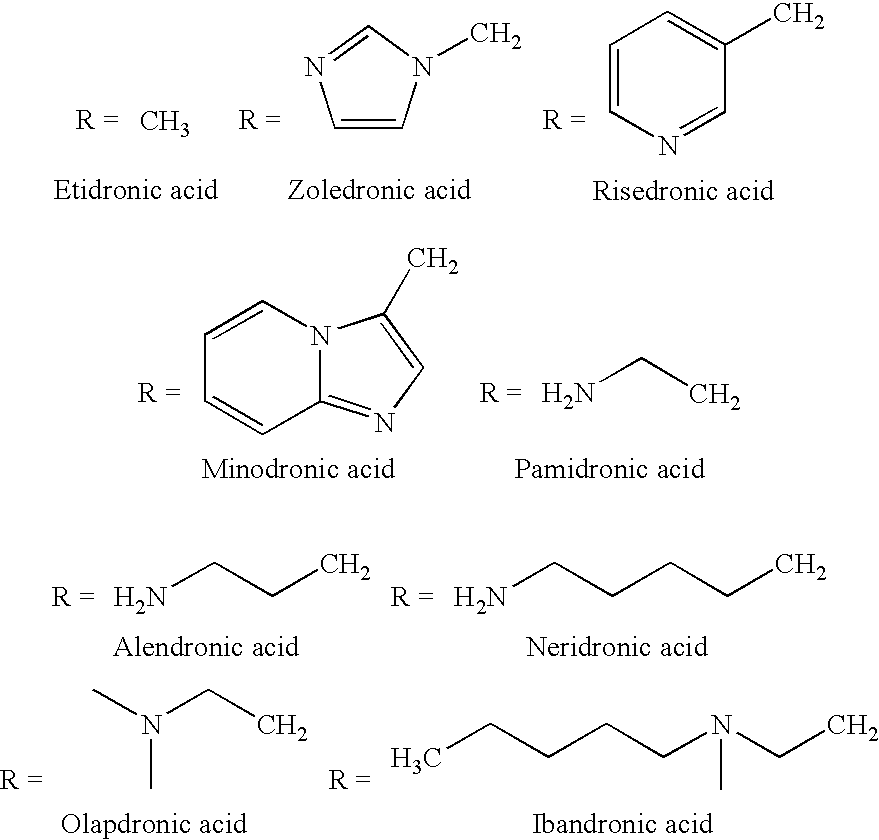Process for the preparation of biphosphonic derivatives
a technology of biphosphonic acid and derivatives, which is applied in the direction of phosphorous compound active ingredients, biocide, group 5/15 element organic compounds, etc., can solve the problems of little difficulty in adapting these processes to an industrial scale, obtaining solid and unstimulable masses, and inconsistent yields
- Summary
- Abstract
- Description
- Claims
- Application Information
AI Technical Summary
Benefits of technology
Problems solved by technology
Method used
Image
Examples
examples-1
Preparation of (4-Amino-1-hydroxybutylidene) Bisphosphonic Acid (Alendronic Acid)
[0038]The suspension of 4-amino butyric acid (10.0 g) and phosphorous acid (23.9 g) in diphenyl ether (50 ml) was heated up to 70° C. for 1 hour. Phosphorous trichloride (25.4 ml) was slowly added to reaction mass at 70° C. temperature and maintained reaction temperature for another 6 hours. Reaction mass was cooled to 25° C. followed by addition of water (150 ml) and toluene (30 ml). Reaction mixture was again heated to 70° C. and charged charcoal in hazy biphasic solution, stirred, filtered through Hyflo bed, washed the bed with hot water (30 ml). Layers was separated from filtrate, aqueous layer was washed with toluene (20 ml) and combined organic layer was then back extracted with water (20 ml) and mixed with main aqueous layer. The water (140 ml) was distilled out from combined aqueous layer at atmospheric pressure in 2 hours and then refluxed the concentrated mass for 13 hours. Reaction mass was c...
examples-2
Preparation of Zoledronic Acid
[0040]The suspension of (1-imidazoyl)ethanoic acid (10.0 g) and phosphorous acid (19.5 g) in diphenyl ether (50 ml) was heated up to 70° C. for 1 hour. Phosphorous trichloride (20 ml) was slowly added to reaction mass at 70° C. temperature and maintained reaction temperature for another 6 hours. Reaction mass was cooled to 25° C. followed by addition of water (150 ml) and toluene (30 ml). Reaction mixture was again heated to 70° C. and charged charcoal in hazy biphasic solution, stirred, filtered through Hyflo bed, washed the bed with hot water (30 ml). Layers was separated from filtrate, aqueous layer was washed with toluene (20 ml) and combined organic layer was then back extracted with water (20 ml) and mixed with main aqueous layer. The water (140 ml) was distilled out from combined aqueous layer at atmospheric pressure in 2 hours and then refluxed the concentrated mass for 13 hours. Reaction mass was cooled to 25° C. followed by addition of methano...
examples-3
Preparation of Risedronic Acid
[0042]The suspension of (3-pyridyl)ethanoic acid (10.0 g) and phosphorous acid (17.9 g) in diphenyl ether (50 ml) was heated up to 70° C. for 1 hour. Phosphorous trichloride (19.1 ml) was slowly added to reaction mass at 70° C. temperature and maintained reaction temperature for another 6 hours. Reaction mass was cooled to 25° C. followed by addition of water (150 ml) and toluene (30 ml). The reaction mixture was again heated to 70° C. and charged charcoal in hazy biphasic solution, stirred, filtered through Hyflo bed, washed the bed with hot water (30 ml). Layers was separated from filtrate, aqueous layer was washed with toluene (20 ml) and combined organic layer was then back extracted with water (20 ml) and mixed with main aqueous layer. The water (140 ml) was distilled out from combined aqueous layer at atmospheric pressure in 2 hours and then refluxed the concentrated mass for 13 hours. Reaction mass was cooled to 25° C. followed by addition of met...
PUM
| Property | Measurement | Unit |
|---|---|---|
| temperature | aaaaa | aaaaa |
| temperature | aaaaa | aaaaa |
| temperature | aaaaa | aaaaa |
Abstract
Description
Claims
Application Information
 Login to View More
Login to View More - R&D
- Intellectual Property
- Life Sciences
- Materials
- Tech Scout
- Unparalleled Data Quality
- Higher Quality Content
- 60% Fewer Hallucinations
Browse by: Latest US Patents, China's latest patents, Technical Efficacy Thesaurus, Application Domain, Technology Topic, Popular Technical Reports.
© 2025 PatSnap. All rights reserved.Legal|Privacy policy|Modern Slavery Act Transparency Statement|Sitemap|About US| Contact US: help@patsnap.com



